Home / A Gallery of Some Interesting Molecules From Nature
Fun and Miscellaneous
A Gallery of Some Interesting Molecules From Nature
Last updated: September 22nd, 2022 |
A Gallery of Interesting Molecules from Nature
[In which we inch our way, very very slowly, towards spectroscopy and structure determination]
Recently I wrote about my experience of finding a bottle of “White Tail Doe Urine” in the back of my rental car and how this led to a search of the chemical literature for what we know about the molecules (over 60 of them) contained in this golden liquid. If you’ve read that post or for that matter, had any curiosity at all about biology and chemistry, you’ll know by now that living organisms are veritable chemical factories, producing a vast array of molecules that serve as pigments, pheromones, defensive toxins, hormones, sources of energy storage, and many other uses [or sometimes, no discernible use at all]. At last count (2014), over 326,000 compounds have been isolated and characterized from organisms. We refer to these molecules as “natural products”. Among these 326,000 natural products are many familiar names – chlorophyll, caffeine, vitamin C, riboflavin, and erythromycin, to name just a few. There are whole journals devoted to their study, such as the Journal of Natural Products, Natural Product Reports, Natural Product Updates, and many others.
After you’ve learned some organic chemistry, these become more than just words on the ingredients list of a food wrapper or in a medicine. By being able to “read” chemical structures, you can start to understand reality at a deeper level.
Have you ever wondered:
• what gives rise to colors?
• what are toxins, specifically? and why are they toxic in the first place? How do toxins work?
• what gives rise to scents and smells? What is specifically responsible for the smell of roses, pine forests, or for that matter, poo ?
• what are pheromones? and do they really work?
• what do drugs and drug-like molecules look like? And are there any features they tend to have in common?
There are molecules responsible for each of these phenomena, and learning about them gives you a greater appreciation for how organisms work at the molecular level, and how organisms evolve and co-evolve.
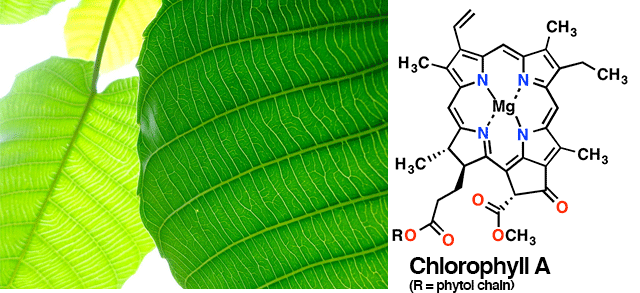
One of the books that really turned me on to organic chemistry was the Merck Index, which is a doorstop of a tome containing 10,000 entries about molecules from the world around us, along with literature references and historical notes. [Cheap older version on Amazon – there is also an online version, but it doesn’t allow as much serendipitous discovery by browsing en crappeur, which is the whole point, in my opinion.]
What made the Merck great for me was that it turned all these words I’d learned from reading the sides of cereal boxes as a kid – (riboflavin, Vitamin C, niacin, folic acid, BHT… ) and others picked up along the way (chlorophyll, penicillin, estrogen, acetominophen, THC, morphine, mescaline, Vitamin C, Vitamin B12, calciferol…) – and showed their structures. Pre-Wikipedia, having a source that put all these things together was a revelation.
Going through a source like the Merck, you can recognize that the concepts you learn in the first few chapters of an organic chemistry textbook are not esoteric academic curiosities. Bonding, geometry, acid-base characteristics, functional groups, stereochemistry and even conformations are all relevant to the understanding of molecules from nature as well as the vast array of medicines they have inspired. You also start to see that there are repeating patterns of natural products – steroids, terpenes, polyketides, flavanoids, iridoids, alkaloids, and many others.
Down the road, you might find (as I did) yourself asking questions like:
- What’s the molecule (or molecules) responsible for that (smell, flavour, poison, color)?
- What does that [molecule with weird name] look like?
- What’s the structure of the active ingredient in that [drug, pesticide, supplement]?
Organic chemistry is literally everywhere around you.
In that vein, this post simply aims to show the structures of some chemicals behind some of our everyday sights and smells (as well as a few more exotic ones). Like the Merck, the the list could be 10,000 molecules long. In the end, it is 15. [If there are other molecules you happen to find particularly interesting, go ahead and leave a comment below]. They all have Wikipedia entries if you find the brief factoids are unsatisfying.
The Smell of Earth – Geosmin
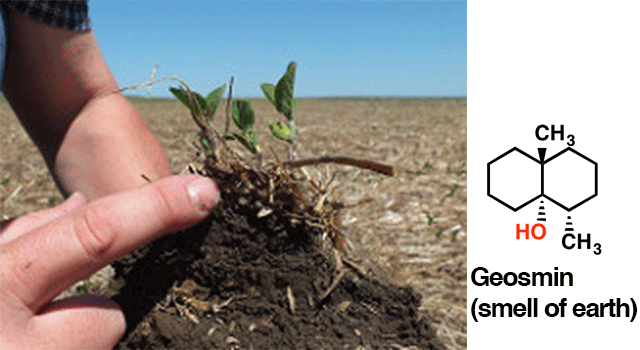
Yes – there’s a molecule our noses associate with the smell of earth. Geosmin is produced by actinobacteria in the soil and is largely responsible for that “it just rained” smell. [As a side note, so does tert-butyldimethylsilyl chloride, which must be hitting the same olfactory receptor]. This molecule has a decalin structure (two fused six-membered rings) and has a tertiary alcohol at one of the ring junctions. I wonder how/if converting the alcohol to an ether would change the odor? [Interesting paper on how small differences in structure can lead to different smells – stereochemistry is important!]
Rose Oil – Geraniol
A major component of rose oil (but by no means the only one), geraniol belongs to the large class of molecules known as terpenoids – natural products built from the 5-carbon isoprene unit and modified in thousands of different ways. In the case of geraniol, there are two isoprene units, making it a “monoterpene” in the slightly confusing nomenclature of these molecules. The smell of rose oil is largely due to the contributions of α-damascenone and β-damascenone , also terpenoids, but there are dozens of individual contributors.
Why would roses (and other plants) bother producing these molecules at all? The answer is that these scents attract pollinators, such as bees and moths, who can detect them at extremely low concentrations.
Geraniol also turns out to be a building block of many terpenes and terpenoids, primarily via geraniol diphosphate (diphosphate is nature’s way of turning alcohols into good leaving groups).
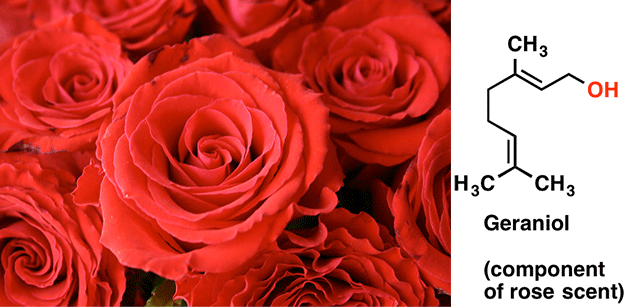
The Smell of Turds – Skatole
The name says it all. A metabolite of the amino acid tryptophan, skatole has a distinct fecal odor. You can imagine the co-evolution that took place here – we’ve evolved to find the smell of skatole repugnant in response to the harmful nature of e.coli and other harmful bacteria present in feces.

The “Hot” Taste of Chili Peppers – Capsaicin
Since plants can’t exactly run away, in order to deter predators they often rely on producing molecules that are feeding deterrents. Capsaicin is the molecule most responsible for the “hotness” of chili peppers: it hits receptors on the cell membrane also activated by heat, abrasion, and acid. Commercially available pepper spray also contains capsaicin.
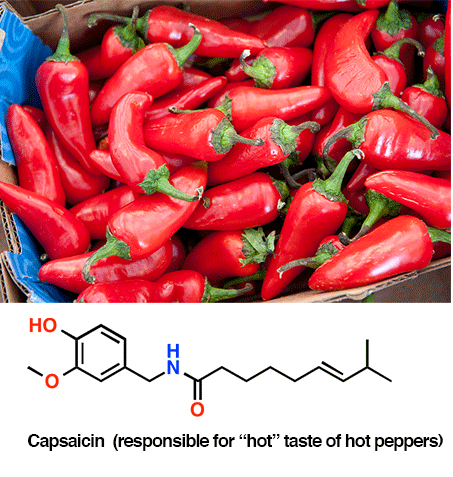
Housefly Sex Attractant – (9Z Tricosene).
Insects that wish to mate are trying to solve the same problem as flowering plants that wish to attract pollinators. In order to do so, they emit characteristic molecules that can be detected by their partners in minute concentrations at a considerable distance. In the case of the silkworm moth bombyx mori, a single molecule of the pheromone bombykol was found to elicit a nervous response. The discovery of insect sex pheromones has led to the development of pheromone traps as a popular alternative to pesticides.
The molecule below is (Z)-9-tricosene, the pheromone that female houseflies release to attract males. This chemical, commercially known as Muscalure, is synthesized in mass quantities and used in traps such as fly paper.
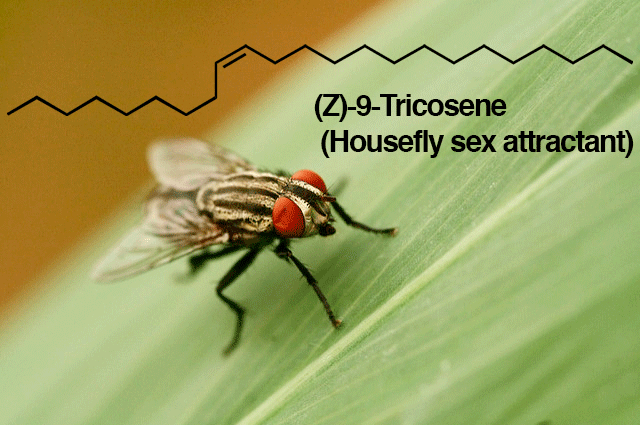
Luminescence of Fireflies – Luciferin
Luciferin, produced by fireflies, reacts with molecular oxygen to produce an unstable intermediate [1,2-dioxetane] that releases light upon decomposition [glowsticks are based on the same chemical pathway]. The five membered ring containing the sulfur and nitrogen is called a thiazole ; when fused with a benzene ring, it’s a benzothiazole (as in on the left); when one of the double bonds has been removed, it’s a dihydrothiazole.
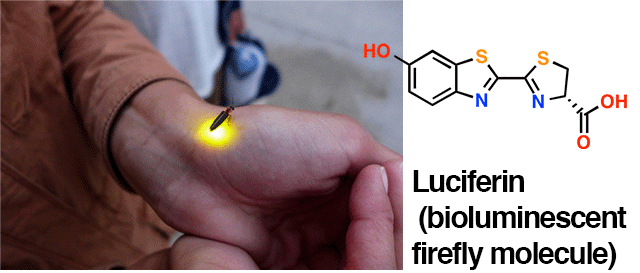
Frog Toxin – Epibatidine
Many species of tropical frogs produce toxic contact poisons, of which epibatidine is one example of many. These poisons tend to be part of the large class of nitrogen-containing natural products known as alkaloids . The production of toxic alkaloids is tied to the frogs’ diet of beetles and other insects: frogs kept in captivity don’t produce the toxin. Another fascinating example is batrachotoxin, a steroid alkaloid, which native tribes in South America have used to tip their spears and arrows for hunting prey.
On the left of the structure of epibatidine you’ll notice an aromatic ring containing a nitrogen (a “pyridine” ring) with an adjacent chlorine. On the right there is a bicyclic structure [7-azabicyclo[2.2.1]heptane] containing a secondary amine.
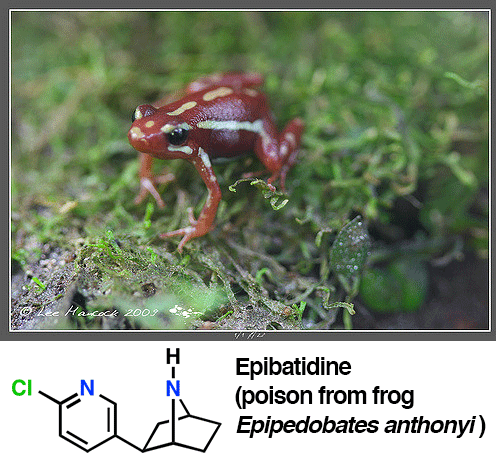
Arrow Poison – Tubocurarine Chloride
Another contact poison (and alkaloid) from South America is tubocurarine chloride , isolated from the vine of chondrodendron tomentosum . Arrow poisons are generally known as “curares” . Note how the molecule is a salt – that nitrogen on the left is a quaternary ammonium with a formal charge of +1. This molecule paralyzes rather than kills – it was used for decades as an anaesthetic, before better alternatives (less troublesome for children and pregnant women) were developed.
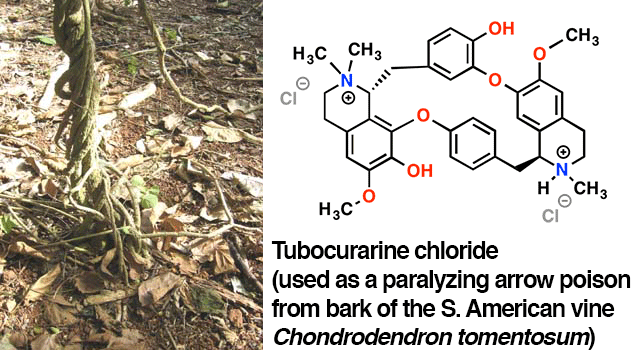
The smell of cherries and cinnamon – benzaldehyde and cinnamaldehyde
Crack open a bottle of benzaldehyde and you will be blown away by the concentrated, unmistakable smell of cherries (and the cherry-ish scent we often encounter in lozenges, shampoos, and soap). The smell of cinnamon comes from a remarkably similar molecule – cinnamaldehyde has a double bond between the benzene ring and the aldehyde. In grad school, my research project required me to work with cinnemaldehyde for a week. That weekend I visited Ikea and they were selling fresh cinnamon buns. Let me tell you – after working with cinnemaldehyde in the lab, the thought of eating cinnamon buns is not tempting.
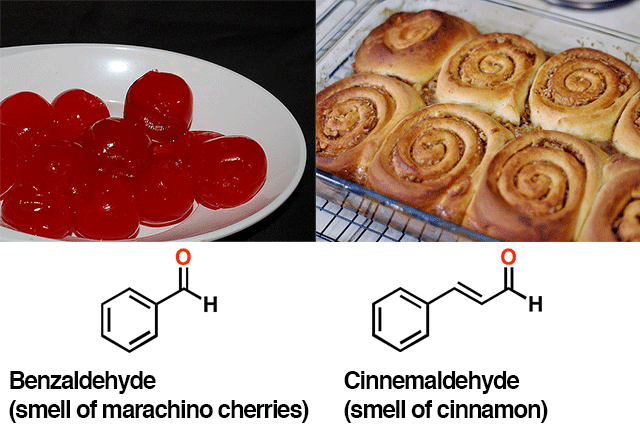
Smell of pines and other conifers – alpha and beta pinene
If you’ve ever cleaned with Pine-Sol, or worked with turpentine, you’ve smelled the pinenes. These are in the terpene family too, just like geraniol – each are made up of two 5-carbon isoprene units for a total of 10 carbons each. That four-membered ring should scream out “ring strain” to you, but interestingly, cyclobutanes (and cyclopropanes) are occasionally found in nature. Interestingly, these molecules are biosynthesized from geraniol.
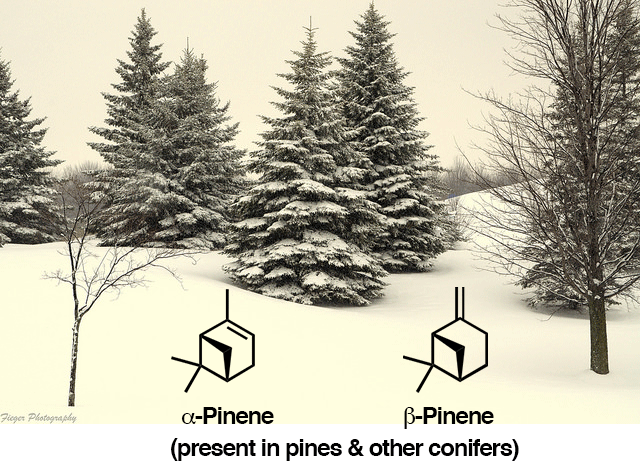
Catnip – Nepetalactone
The catnip plant, Nepata cataria, produces a fragrance that elicits a flurry of rolling, scratching, and purring in about two thirds of domestic cats (and bigger felines, apparently). As it turns out, nepetelactone – the compound produced by the plant – serves as an insect repellent. The effect on cats is an accident of its similarity to cat pheromones.
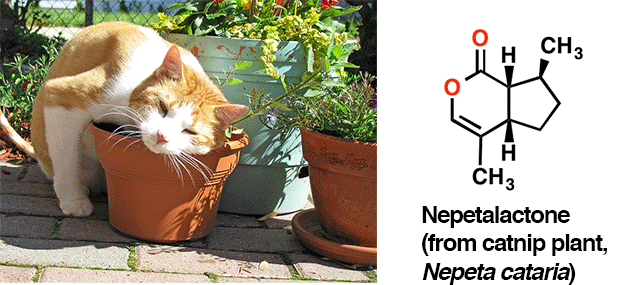
Opium – Morphine
To a beginner, morphine looks hopelessly complex in all its polycyclic three-dimensional glory. Five rings, multiple hydroxyl groups, a cyclic ether, a tertiary amine, 5 stereocenters – that’s a lot of action in a molecule containing only 17 carbons.
Morphine is actually a great lesson in how complex molecules can arise from relatively simple precursors. Oxidation of the benzylisoquinoline alkaloid reticuline – not too complicated a molecule – results in formation of the crucial C-C bond that connects the phenol ring with the bottom-most six membered ring. This is a common theme in natural product biosynthesis, by the way: complexity by way of oxidation of simpler precursors.
Treating morphine with acetic anhydride gives you heroin (not a natural product). The partially methylated version is codeine (also present in opium).
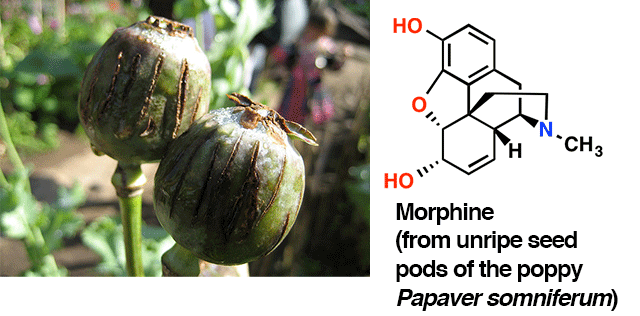
Antibiotic – Penicillin V
Alexander Fleming famously observed in 1928 that one of his staphylcocci cultures had developed a fungus and the colonies around the fungus had been destroyed. The structure of the key antibacterial agent was elucidated in 1945 by Dorothy Crowfoot Hodgkin using X-ray crystallography. The key to antibiotic activity is the beta lactam ring (cyclic amide 4-membered ring) which inhibits formation of the bacterial cell wall. There is a large family of these molecules, largely differing by the identity of the group forming the amide in the bottom left part of the molecule. The molecule shown (Penicillin V) was later synthesized (after heroic effort) by John Sheehan and colleagues at MIT in 1951.
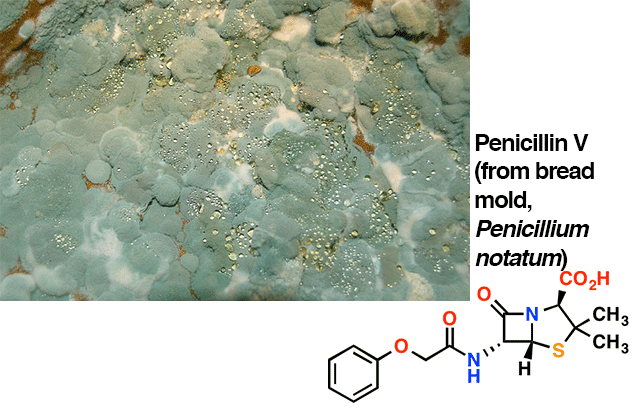
Tomato Pigment – Lycopene
One of the most familiar of the fifteen causes of color from chemistry and physics is the color arising from molecular orbitals. Molecules with pi bonds can absorb a photon corresponding to the gap in energy ( ΔE )between their highest occupied molecular orbital (HOMO) and lowest unoccupied molecular orbital (LUMO). For a molecule like ethene, with one double bond, this requires very high energy photons (in the UV). However, this energy gap decreases as the number of conjugated pi bonds in the pi system increases. In the case of chlorophyll (above) that energy gap corresponds to photons in the
Lycopene is a 40-carbon member of the terpene family (a “tetraterpene”) and has 10 conjugated double bonds. In the case of lycopene, the wavelength of the photon required is in the blue region of the visible spectrum. We see the complementary color (red).
The fact that color is caused by highly conjugated pi systems (e.g. in heme, chlorophyll, b-carotene and others) is one reason why bleach works so well. Bleach + water reacts with the double bonds. This might not remove the molecule, but it removes the source of the color!
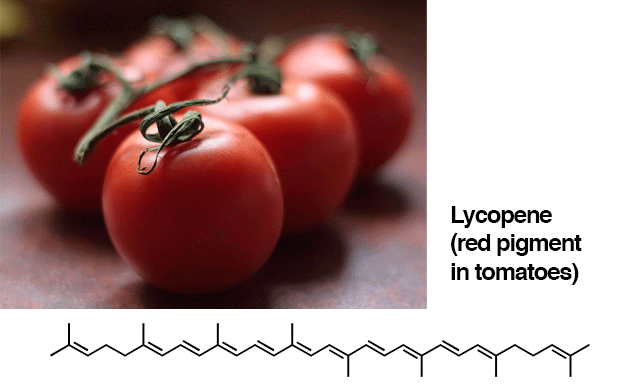
Deer Tarsal Pheromone
Let’s end this where we started: with deer. Male black-tailed deer emit pheromones from their tarsal gland. The major component is the unsaturated lactone below. The scent emitted from this gland serves an identifier for each deer and is how deer separate “strange” from familiar individuals.
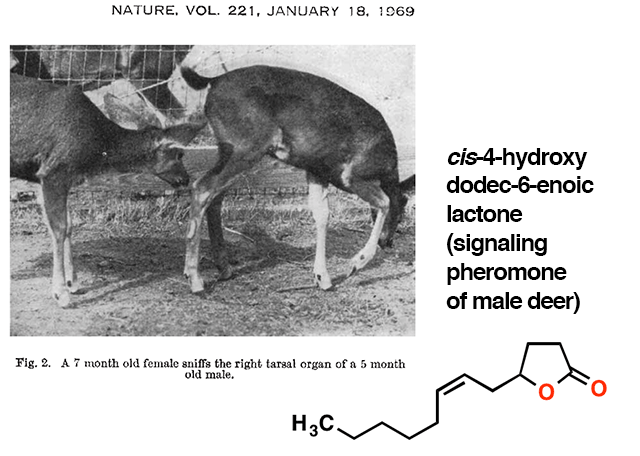

Top Secret no longer
What Next?
That’s enough molecules for now – although if you have “favourite” molecules that you find interesting, by all means post them in the comments below.
Let’s ask the next question. Say you’re curious about the active component of a plant – catnip, for example. You’re asking yourself, “what’s the molecule (or molecules) responsible for this effect?”.
How do you go from being curious about the active component of a plant, animal, or insect, to isolating it, and then actually determining its structure? What’s the sequence of steps?
In this series of posts, we’re going to start exploring this question!
Next post: Extracting Molecules From Organisms
00 General Chemistry Review
01 Bonding, Structure, and Resonance
- How Do We Know Methane (CH4) Is Tetrahedral?
- Hybrid Orbitals and Hybridization
- How To Determine Hybridization: A Shortcut
- Orbital Hybridization And Bond Strengths
- Sigma bonds come in six varieties: Pi bonds come in one
- Dipole Moments and Dipoles
- A Key Skill: How to Calculate Formal Charge
- The Four Intermolecular Forces and How They Affect Boiling Points
- 3 Trends That Affect Boiling Points
- How To Use Electronegativity To Determine Electron Density (and why NOT to trust formal charge)
- Introduction to Resonance
- How To Use Curved Arrows To Interchange Resonance Forms
- Evaluating Resonance Forms (1) - The Rule of Least Charges
- How To Find The Best Resonance Structure By Applying Electronegativity
- Evaluating Resonance Structures With Negative Charges
- Evaluating Resonance Structures With Positive Charge
- Exploring Resonance: Pi-Donation
- Exploring Resonance: Pi-acceptors
- In Summary: Evaluating Resonance Structures
- Drawing Resonance Structures: 3 Common Mistakes To Avoid
- How to apply electronegativity and resonance to understand reactivity
- Bond Hybridization Practice
- Structure and Bonding Practice Quizzes
- Resonance Structures Practice
02 Acid Base Reactions
- Introduction to Acid-Base Reactions
- Acid Base Reactions In Organic Chemistry
- The Stronger The Acid, The Weaker The Conjugate Base
- Walkthrough of Acid-Base Reactions (3) - Acidity Trends
- Five Key Factors That Influence Acidity
- Acid-Base Reactions: Introducing Ka and pKa
- How to Use a pKa Table
- The pKa Table Is Your Friend
- A Handy Rule of Thumb for Acid-Base Reactions
- Acid Base Reactions Are Fast
- pKa Values Span 60 Orders Of Magnitude
- How Protonation and Deprotonation Affect Reactivity
- Acid Base Practice Problems
03 Alkanes and Nomenclature
- Meet the (Most Important) Functional Groups
- Condensed Formulas: Deciphering What the Brackets Mean
- Hidden Hydrogens, Hidden Lone Pairs, Hidden Counterions
- Don't Be Futyl, Learn The Butyls
- Primary, Secondary, Tertiary, Quaternary In Organic Chemistry
- Branching, and Its Affect On Melting and Boiling Points
- The Many, Many Ways of Drawing Butane
- Wedge And Dash Convention For Tetrahedral Carbon
- Common Mistakes in Organic Chemistry: Pentavalent Carbon
- Table of Functional Group Priorities for Nomenclature
- Summary Sheet - Alkane Nomenclature
- Organic Chemistry IUPAC Nomenclature Demystified With A Simple Puzzle Piece Approach
- Boiling Point Quizzes
- Organic Chemistry Nomenclature Quizzes
04 Conformations and Cycloalkanes
- Staggered vs Eclipsed Conformations of Ethane
- Conformational Isomers of Propane
- Newman Projection of Butane (and Gauche Conformation)
- Introduction to Cycloalkanes
- Geometric Isomers In Small Rings: Cis And Trans Cycloalkanes
- Calculation of Ring Strain In Cycloalkanes
- Cycloalkanes - Ring Strain In Cyclopropane And Cyclobutane
- Cyclohexane Conformations
- Cyclohexane Chair Conformation: An Aerial Tour
- How To Draw The Cyclohexane Chair Conformation
- The Cyclohexane Chair Flip
- The Cyclohexane Chair Flip - Energy Diagram
- Substituted Cyclohexanes - Axial vs Equatorial
- Ranking The Bulkiness Of Substituents On Cyclohexanes: "A-Values"
- Cyclohexane Chair Conformation Stability: Which One Is Lower Energy?
- Fused Rings - Cis-Decalin and Trans-Decalin
- Naming Bicyclic Compounds - Fused, Bridged, and Spiro
- Bredt's Rule (And Summary of Cycloalkanes)
- Newman Projection Practice
- Cycloalkanes Practice Problems
05 A Primer On Organic Reactions
- The Most Important Question To Ask When Learning a New Reaction
- Curved Arrows (for reactions)
- Nucleophiles and Electrophiles
- The Three Classes of Nucleophiles
- Nucleophilicity vs. Basicity
- What Makes A Good Nucleophile?
- What Makes A Good Leaving Group?
- 3 Factors That Stabilize Carbocations
- Equilibrium and Energy Relationships
- 7 Factors that stabilize negative charge in organic chemistry
- 7 Factors That Stabilize Positive Charge in Organic Chemistry
- What's a Transition State?
- Hammond's Postulate
- Learning Organic Chemistry Reactions: A Checklist (PDF)
06 Free Radical Reactions
- Free Radical Reactions
- 3 Factors That Stabilize Free Radicals
- Bond Strengths And Radical Stability
- Free Radical Initiation: Why Is "Light" Or "Heat" Required?
- Initiation, Propagation, Termination
- Monochlorination Products Of Propane, Pentane, And Other Alkanes
- Selectivity In Free Radical Reactions
- Selectivity in Free Radical Reactions: Bromination vs. Chlorination
- Halogenation At Tiffany's
- Allylic Bromination
- Bonus Topic: Allylic Rearrangements
- In Summary: Free Radicals
- Synthesis (2) - Reactions of Alkanes
- Free Radicals Practice Quizzes
07 Stereochemistry and Chirality
- Types of Isomers: Constitutional Isomers, Stereoisomers, Enantiomers, and Diastereomers
- How To Draw The Enantiomer Of A Chiral Molecule
- How To Draw A Bond Rotation
- Introduction to Assigning (R) and (S): The Cahn-Ingold-Prelog Rules
- Assigning Cahn-Ingold-Prelog (CIP) Priorities (2) - The Method of Dots
- Enantiomers vs Diastereomers vs The Same? Two Methods For Solving Problems
- Assigning R/S To Newman Projections (And Converting Newman To Line Diagrams)
- How To Determine R and S Configurations On A Fischer Projection
- The Meso Trap
- Optical Rotation, Optical Activity, and Specific Rotation
- Optical Purity and Enantiomeric Excess
- What's a Racemic Mixture?
- Chiral Allenes And Chiral Axes
- Stereochemistry Practice Problems and Quizzes
08 Substitution Reactions
- Nucleophilic Substitution Reactions - Introduction
- Two Types of Nucleophilic Substitution Reactions
- The SN2 Mechanism
- Why the SN2 Reaction Is Powerful
- The SN1 Mechanism
- The Conjugate Acid Is A Better Leaving Group
- Comparing the SN1 and SN2 Reactions
- Polar Protic? Polar Aprotic? Nonpolar? All About Solvents
- Steric Hindrance is Like a Fat Goalie
- Common Blind Spot: Intramolecular Reactions
- Substitution Practice - SN1
- Substitution Practice - SN2
09 Elimination Reactions
- Elimination Reactions (1): Introduction And The Key Pattern
- Elimination Reactions (2): The Zaitsev Rule
- Elimination Reactions Are Favored By Heat
- Two Elimination Reaction Patterns
- The E1 Reaction
- The E2 Mechanism
- E1 vs E2: Comparing the E1 and E2 Reactions
- Antiperiplanar Relationships: The E2 Reaction and Cyclohexane Rings
- Bulky Bases in Elimination Reactions
- Comparing the E1 vs SN1 Reactions
- Elimination (E1) Reactions With Rearrangements
- E1cB - Elimination (Unimolecular) Conjugate Base
- Elimination (E1) Practice Problems And Solutions
- Elimination (E2) Practice Problems and Solutions
10 Rearrangements
11 SN1/SN2/E1/E2 Decision
- Identifying Where Substitution and Elimination Reactions Happen
- Deciding SN1/SN2/E1/E2 (1) - The Substrate
- Deciding SN1/SN2/E1/E2 (2) - The Nucleophile/Base
- SN1 vs E1 and SN2 vs E2 : The Temperature
- Deciding SN1/SN2/E1/E2 - The Solvent
- Wrapup: The Key Factors For Determining SN1/SN2/E1/E2
- Alkyl Halide Reaction Map And Summary
- SN1 SN2 E1 E2 Practice Problems
12 Alkene Reactions
- E and Z Notation For Alkenes (+ Cis/Trans)
- Alkene Stability
- Alkene Addition Reactions: "Regioselectivity" and "Stereoselectivity" (Syn/Anti)
- Stereoselective and Stereospecific Reactions
- Hydrohalogenation of Alkenes and Markovnikov's Rule
- Hydration of Alkenes With Aqueous Acid
- Rearrangements in Alkene Addition Reactions
- Halogenation of Alkenes and Halohydrin Formation
- Oxymercuration Demercuration of Alkenes
- Hydroboration Oxidation of Alkenes
- m-CPBA (meta-chloroperoxybenzoic acid)
- OsO4 (Osmium Tetroxide) for Dihydroxylation of Alkenes
- Palladium on Carbon (Pd/C) for Catalytic Hydrogenation of Alkenes
- Cyclopropanation of Alkenes
- A Fourth Alkene Addition Pattern - Free Radical Addition
- Alkene Reactions: Ozonolysis
- Oxidative Cleavage of Vicinal Diols With NaIO4 and Pb(OAc)4
- Summary: Three Key Families Of Alkene Reaction Mechanisms
- Synthesis (4) - Alkene Reaction Map, Including Alkyl Halide Reactions
- Alkene Reactions Practice Problems
13 Alkyne Reactions
- Acetylides from Alkynes, And Substitution Reactions of Acetylides
- Partial Reduction of Alkynes With Lindlar's Catalyst
- Partial Reduction of Alkynes With Na/NH3 To Obtain Trans Alkenes
- Alkyne Hydroboration With "R2BH"
- Hydration and Oxymercuration of Alkynes
- Hydrohalogenation of Alkynes
- Alkyne Halogenation: Bromination and Chlorination of Alkynes
- Oxidation of Alkynes With O3 and KMnO4
- Alkenes To Alkynes Via Halogenation And Elimination Reactions
- Alkynes Are A Blank Canvas
- Synthesis (5) - Reactions of Alkynes
- Alkyne Reactions Practice Problems With Answers
14 Alcohols, Epoxides and Ethers
- Alcohols - Nomenclature and Properties
- Alcohols Can Act As Acids Or Bases (And Why It Matters)
- Alcohols - Acidity and Basicity
- The Williamson Ether Synthesis
- Ethers From Alkenes, Tertiary Alkyl Halides and Alkoxymercuration
- Alcohols To Ethers via Acid Catalysis
- Cleavage Of Ethers With Acid
- Epoxides - The Outlier Of The Ether Family
- Opening of Epoxides With Acid
- Epoxide Ring Opening With Base
- Making Alkyl Halides From Alcohols
- Tosylates And Mesylates
- PBr3 and SOCl2
- Elimination Reactions of Alcohols
- Elimination of Alcohols To Alkenes With POCl3
- Alcohol Oxidation: "Strong" and "Weak" Oxidants
- Demystifying The Mechanisms of Alcohol Oxidations
- Protecting Groups For Alcohols
- Thiols And Thioethers
- Calculating the oxidation state of a carbon
- Oxidation and Reduction in Organic Chemistry
- Oxidation Ladders
- SOCl2 Mechanism For Alcohols To Alkyl Halides: SN2 versus SNi
- Alcohol Reactions Roadmap (PDF)
- Alcohol Reaction Practice Problems
- Epoxide Reaction Quizzes
- Oxidation and Reduction Practice Quizzes
15 Organometallics
- What's An Organometallic?
- Formation of Grignard and Organolithium Reagents
- Organometallics Are Strong Bases
- Reactions of Grignard Reagents
- Protecting Groups In Grignard Reactions
- Synthesis Problems Involving Grignard Reagents
- Grignard Reactions And Synthesis (2)
- Organocuprates (Gilman Reagents): How They're Made
- Gilman Reagents (Organocuprates): What They're Used For
- The Heck, Suzuki, and Olefin Metathesis Reactions (And Why They Don't Belong In Most Introductory Organic Chemistry Courses)
- Reaction Map: Reactions of Organometallics
- Grignard Practice Problems
16 Spectroscopy
- Degrees of Unsaturation (or IHD, Index of Hydrogen Deficiency)
- Conjugation And Color (+ How Bleach Works)
- Introduction To UV-Vis Spectroscopy
- UV-Vis Spectroscopy: Absorbance of Carbonyls
- UV-Vis Spectroscopy: Practice Questions
- Bond Vibrations, Infrared Spectroscopy, and the "Ball and Spring" Model
- Infrared (IR) Spectroscopy: A Quick Primer On Interpreting Spectra
- IR Spectroscopy: 4 Practice Problems
- 1H NMR: How Many Signals?
- Homotopic, Enantiotopic, Diastereotopic
- Diastereotopic Protons in 1H NMR Spectroscopy: Examples
- 13-C NMR - How Many Signals
- Liquid Gold: Pheromones In Doe Urine
- Natural Product Isolation (1) - Extraction
- Natural Product Isolation (2) - Purification Techniques, An Overview
- Structure Determination Case Study: Deer Tarsal Gland Pheromone
17 Dienes and MO Theory
- What To Expect In Organic Chemistry 2
- Are these molecules conjugated?
- Conjugation And Resonance In Organic Chemistry
- Bonding And Antibonding Pi Orbitals
- Molecular Orbitals of The Allyl Cation, Allyl Radical, and Allyl Anion
- Pi Molecular Orbitals of Butadiene
- Reactions of Dienes: 1,2 and 1,4 Addition
- Thermodynamic and Kinetic Products
- More On 1,2 and 1,4 Additions To Dienes
- s-cis and s-trans
- The Diels-Alder Reaction
- Cyclic Dienes and Dienophiles in the Diels-Alder Reaction
- Stereochemistry of the Diels-Alder Reaction
- Exo vs Endo Products In The Diels Alder: How To Tell Them Apart
- HOMO and LUMO In the Diels Alder Reaction
- Why Are Endo vs Exo Products Favored in the Diels-Alder Reaction?
- Diels-Alder Reaction: Kinetic and Thermodynamic Control
- The Retro Diels-Alder Reaction
- The Intramolecular Diels Alder Reaction
- Regiochemistry In The Diels-Alder Reaction
- The Cope and Claisen Rearrangements
- Electrocyclic Reactions
- Electrocyclic Ring Opening And Closure (2) - Six (or Eight) Pi Electrons
- Diels Alder Practice Problems
- Molecular Orbital Theory Practice
18 Aromaticity
- Introduction To Aromaticity
- Rules For Aromaticity
- Huckel's Rule: What Does 4n+2 Mean?
- Aromatic, Non-Aromatic, or Antiaromatic? Some Practice Problems
- Antiaromatic Compounds and Antiaromaticity
- The Pi Molecular Orbitals of Benzene
- The Pi Molecular Orbitals of Cyclobutadiene
- Frost Circles
- Aromaticity Practice Quizzes
19 Reactions of Aromatic Molecules
- Electrophilic Aromatic Substitution: Introduction
- Activating and Deactivating Groups In Electrophilic Aromatic Substitution
- Electrophilic Aromatic Substitution - The Mechanism
- Ortho-, Para- and Meta- Directors in Electrophilic Aromatic Substitution
- Understanding Ortho, Para, and Meta Directors
- Why are halogens ortho- para- directors?
- Disubstituted Benzenes: The Strongest Electron-Donor "Wins"
- Electrophilic Aromatic Substitutions (1) - Halogenation of Benzene
- Electrophilic Aromatic Substitutions (2) - Nitration and Sulfonation
- EAS Reactions (3) - Friedel-Crafts Acylation and Friedel-Crafts Alkylation
- Intramolecular Friedel-Crafts Reactions
- Nucleophilic Aromatic Substitution (NAS)
- Nucleophilic Aromatic Substitution (2) - The Benzyne Mechanism
- Reactions on the "Benzylic" Carbon: Bromination And Oxidation
- The Wolff-Kishner, Clemmensen, And Other Carbonyl Reductions
- More Reactions on the Aromatic Sidechain: Reduction of Nitro Groups and the Baeyer Villiger
- Aromatic Synthesis (1) - "Order Of Operations"
- Synthesis of Benzene Derivatives (2) - Polarity Reversal
- Aromatic Synthesis (3) - Sulfonyl Blocking Groups
- Birch Reduction
- Synthesis (7): Reaction Map of Benzene and Related Aromatic Compounds
- Aromatic Reactions and Synthesis Practice
- Electrophilic Aromatic Substitution Practice Problems
20 Aldehydes and Ketones
- What's The Alpha Carbon In Carbonyl Compounds?
- Nucleophilic Addition To Carbonyls
- Aldehydes and Ketones: 14 Reactions With The Same Mechanism
- Sodium Borohydride (NaBH4) Reduction of Aldehydes and Ketones
- Grignard Reagents For Addition To Aldehydes and Ketones
- Wittig Reaction
- Hydrates, Hemiacetals, and Acetals
- Imines - Properties, Formation, Reactions, and Mechanisms
- All About Enamines
- Breaking Down Carbonyl Reaction Mechanisms: Reactions of Anionic Nucleophiles (Part 2)
- Aldehydes Ketones Reaction Practice
21 Carboxylic Acid Derivatives
- Nucleophilic Acyl Substitution (With Negatively Charged Nucleophiles)
- Addition-Elimination Mechanisms With Neutral Nucleophiles (Including Acid Catalysis)
- Basic Hydrolysis of Esters - Saponification
- Transesterification
- Proton Transfer
- Fischer Esterification - Carboxylic Acid to Ester Under Acidic Conditions
- Lithium Aluminum Hydride (LiAlH4) For Reduction of Carboxylic Acid Derivatives
- LiAlH[Ot-Bu]3 For The Reduction of Acid Halides To Aldehydes
- Di-isobutyl Aluminum Hydride (DIBAL) For The Partial Reduction of Esters and Nitriles
- Amide Hydrolysis
- Thionyl Chloride (SOCl2) And Conversion of Carboxylic Acids to Acid Halides
- Diazomethane (CH2N2)
- Carbonyl Chemistry: Learn Six Mechanisms For the Price Of One
- Making Music With Mechanisms (PADPED)
- Carboxylic Acid Derivatives Practice Questions
22 Enols and Enolates
- Keto-Enol Tautomerism
- Enolates - Formation, Stability, and Simple Reactions
- Kinetic Versus Thermodynamic Enolates
- Aldol Addition and Condensation Reactions
- Reactions of Enols - Acid-Catalyzed Aldol, Halogenation, and Mannich Reactions
- Claisen Condensation and Dieckmann Condensation
- Decarboxylation
- The Malonic Ester and Acetoacetic Ester Synthesis
- The Michael Addition Reaction and Conjugate Addition
- The Robinson Annulation
- Haloform Reaction
- The Hell–Volhard–Zelinsky Reaction
- Enols and Enolates Practice Quizzes
23 Amines
- The Amide Functional Group: Properties, Synthesis, and Nomenclature
- Basicity of Amines And pKaH
- 5 Key Basicity Trends of Amines
- The Mesomeric Effect And Aromatic Amines
- Nucleophilicity of Amines
- Alkylation of Amines (Sucks!)
- Reductive Amination
- The Gabriel Synthesis
- Some Reactions of Azides
- The Hofmann Elimination
- The Hofmann and Curtius Rearrangements
- The Cope Elimination
- Protecting Groups for Amines - Carbamates
- The Strecker Synthesis of Amino Acids
- Introduction to Peptide Synthesis
- Reactions of Diazonium Salts: Sandmeyer and Related Reactions
- Amine Practice Questions
24 Carbohydrates
- D and L Notation For Sugars
- Pyranoses and Furanoses: Ring-Chain Tautomerism In Sugars
- What is Mutarotation?
- Reducing Sugars
- The Big Damn Post Of Carbohydrate-Related Chemistry Definitions
- The Haworth Projection
- Converting a Fischer Projection To A Haworth (And Vice Versa)
- Reactions of Sugars: Glycosylation and Protection
- The Ruff Degradation and Kiliani-Fischer Synthesis
- Isoelectric Points of Amino Acids (and How To Calculate Them)
- Carbohydrates Practice
- Amino Acid Quizzes
25 Fun and Miscellaneous
- A Gallery of Some Interesting Molecules From Nature
- Screw Organic Chemistry, I'm Just Going To Write About Cats
- On Cats, Part 1: Conformations and Configurations
- On Cats, Part 2: Cat Line Diagrams
- On Cats, Part 4: Enantiocats
- On Cats, Part 6: Stereocenters
- Organic Chemistry Is Shit
- The Organic Chemistry Behind "The Pill"
- Maybe they should call them, "Formal Wins" ?
- Why Do Organic Chemists Use Kilocalories?
- The Principle of Least Effort
- Organic Chemistry GIFS - Resonance Forms
- Reproducibility In Organic Chemistry
- What Holds The Nucleus Together?
- How Reactions Are Like Music
- Organic Chemistry and the New MCAT
26 Organic Chemistry Tips and Tricks
- Common Mistakes: Formal Charges Can Mislead
- Partial Charges Give Clues About Electron Flow
- Draw The Ugly Version First
- Organic Chemistry Study Tips: Learn the Trends
- The 8 Types of Arrows In Organic Chemistry, Explained
- Top 10 Skills To Master Before An Organic Chemistry 2 Final
- Common Mistakes with Carbonyls: Carboxylic Acids... Are Acids!
- Planning Organic Synthesis With "Reaction Maps"
- Alkene Addition Pattern #1: The "Carbocation Pathway"
- Alkene Addition Pattern #2: The "Three-Membered Ring" Pathway
- Alkene Addition Pattern #3: The "Concerted" Pathway
- Number Your Carbons!
- The 4 Major Classes of Reactions in Org 1
- How (and why) electrons flow
- Grossman's Rule
- Three Exam Tips
- A 3-Step Method For Thinking Through Synthesis Problems
- Putting It Together
- Putting Diels-Alder Products in Perspective
- The Ups and Downs of Cyclohexanes
- The Most Annoying Exceptions in Org 1 (Part 1)
- The Most Annoying Exceptions in Org 1 (Part 2)
- The Marriage May Be Bad, But the Divorce Still Costs Money
- 9 Nomenclature Conventions To Know
- Nucleophile attacks Electrophile
27 Case Studies of Successful O-Chem Students
- Success Stories: How Corina Got The The "Hard" Professor - And Got An A+ Anyway
- How Helena Aced Organic Chemistry
- From a "Drop" To B+ in Org 2 – How A Hard Working Student Turned It Around
- How Serge Aced Organic Chemistry
- Success Stories: How Zach Aced Organic Chemistry 1
- Success Stories: How Kari Went From C– to B+
- How Esther Bounced Back From a "C" To Get A's In Organic Chemistry 1 And 2
- How Tyrell Got The Highest Grade In Her Organic Chemistry Course
- This Is Why Students Use Flashcards
- Success Stories: How Stu Aced Organic Chemistry
- How John Pulled Up His Organic Chemistry Exam Grades
- Success Stories: How Nathan Aced Organic Chemistry (Without It Taking Over His Life)
- How Chris Aced Org 1 and Org 2
- Interview: How Jay Got an A+ In Organic Chemistry
- How to Do Well in Organic Chemistry: One Student's Advice
- "America's Top TA" Shares His Secrets For Teaching O-Chem
- "Organic Chemistry Is Like..." - A Few Metaphors
- How To Do Well In Organic Chemistry: Advice From A Tutor
- Guest post: "I went from being afraid of tests to actually looking forward to them".
This is a very interesting article. Thanks for making us understand the science of natural molecules.
Also I would like To add caffeine. Because why not? We all love Tea and coffee right? Not only for beverages. Its also used in Tablets and we too use it to calibrate HPLC. Meanwhile caffeine has no Isomers.
It was interesting seeing all of these molecules from nature. A bioluminescent firefly molecule and a rose combination would be cool!
Thank you for providing all of these awesome examples/connections!
wonderful article. Thank you for putting all this great natural products together.It is a beautiful site. Thanks again.
Nice way of introducing Natural Product Chemistry
Cadaverine – the smell of ‘death’, producing by rotting animal tissues. Interestingly, it is also present in small amounts in the semen. Also quite easy to synthesize (I wouldn’t recommend it!)
More here- https://en.wikipedia.org/wiki/Cadaverine
Oh yeah. Completely forgot about putrescine and cadaverine!
Thank you for putting all this nice natural products together. I will definitely request my class to visit this cite.
Vanillin. How could you leave off vanillin? I may or may not have went out of my way to use it as a TLC stain in grad school when just about any other stain would have worked just fine. By far my favorite scent. Soooo good :)
My labmate liked to use vanillin stain, he said, “because it attracts the ladies”. As an organic chemist, you need these small edges.
This a great introduction to the chemistry of natural products.
There are some misspellings, though: cinnemaldehyde (not spelled correctly even once), Nepata, maybe others.
But again, a great post.
Thank you very much, as always.
Epibatidine is one of my favorites. Notice the similarity of the structure to nicotine – 3-substituted pyridine with a 5-member-N-heterocycle. Therefore, epibatidine targets nicotinic receptors, too. The difference is that they bind to nicotinic receptors in muscles, whereas nicotine binds to those in the brain. Dougherty tried to figure out the difference between the different receptors, and couldn’t pin-point anything specific (subtle differences in bond lengths and angles, etc). Because epibatidine targets the muscles, that’s why it leads to paralysis, while nicotine leads to addiction.
For other options, check out Paul May’s pages
http://www.chm.bris.ac.uk/sillymolecules/sillymols.htm
He has a book on it, too “Molecules with Silly or Unusual Names”
A couple of years ago, I did an exercise with elementary kids where we talked molecular structure with model kits, and we talked about how sometimes molecules have descriptive names (chair vs boat, windowpane, etc). So they made their own molecules and gave them names. Dinosaurane, sure, but my favorite was KeyChainane, with interlocking rings.